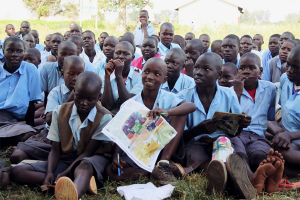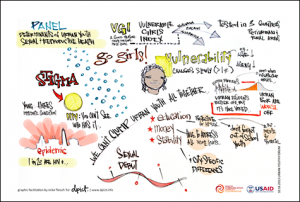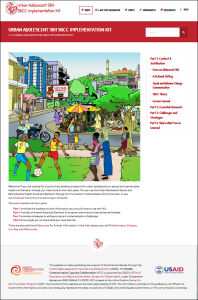
Adolescents in Nwoya District, Uganda, attend an outreach event conducted by Nwoya Youth Center on sexual and reproductive health.
© 2013 Juliette Brown/GlobeMed at UCLA, Courtesy of Photoshare
In 2013, youth ages 10 to 24 accounted for 25 percent of the world’s population. Per the World Health Organization, 16 million girls between ages 15 and 19 and approximately one million girls younger than 15 give birth each year. Most of these girls live in low and middle income countries; Sub-Saharan Africa in particular hosts some of the highest adolescent fertility rates in the world. Early pregnancy and birth is dangerous both to the mother and her child, and are leading causes of death among adolescents globally. Additionally, nearly three million girls ages 15 to 19 have unsafe abortions. The statistics are staggering, and clearly indicate the global community is failing to adequately address the sexual and reproductive health (SRH) and family planning (FP) needs of youth and adolescents. [1],[2]
This is changing, however, and HC3 took part in this shift, leading the way in social and behavior change communication (SBCC). In Nepal, for example, the HC3 project designed a campaign to reposition FP for key populations, including youth and young couples, through enhanced FP counseling and outreach services, street dramas, radio and social media activities. It also worked to make long-acting reversible contraceptives (LARCs) more accessible – a key area of HC3’s global activities for youth as well.
HC3 also brought much-needed attention to SRH of young people living in urban areas, giving special attention to what it means to come of age and truly begin experimenting with independence, relationships and a future in the fast-paced, heterogeneous and media-saturated contexts today’s global cities offer.
Urban Youth SRH SBCC Evidence Exchanges
HC3 created new, innovative tools and resources that reinforce family planning efforts and improve SRH outcomes around the world. A critical step in this process is sharing perspectives and learning from the experience of others.
To help inform the path of its work on urban youth specifically, HC3 held three evidence exchange events in 2013. All three activities explored the work that has been done, or is ongoing, in urban youth SRH and SBCC – and what is needed in the future. These events included:
- An evidence exchange, held on October 16, 2013, in Washington, DC. The day brought together more than 45 participants and guest speakers from more than 15 international and domestic organizations. Through plenary and panel discussions and group activities, attendees broke down the subsets of an “urban youth” population and how best to reach these dynamic groups. A graphic facilitator captured discussion highlights and major themes in a series of illustrations.
- A French-language webinar, held on November 5, 2013. This one-hour session included perspectives from youth representatives from the Association Béninoise pour le Marketing Social et la communication pour la santé (ABMS)/Population Services International (PSI-Benin). Presentations and discussions centered around findings of HC3’s urban youth SRH SBCC literature review, and the roles youth can play in SRH and SBCC activities.
- An English-language webinar, held on November 6, 2013. This second webinar also presented findings from the youth SRH and SBCC literature review and featured a youth activist from Rwanda, who spoke about her reasons for becoming a youth SRH advocate and some common challenges and neglected populations in youth SRH programming.
Urban Youth SRH SBCC Literature Review and Secondary Analysis
HC3 conducted an in-depth literature review and program scan on youth SRH and SBCC programs to examine the design, implementation and evaluation of programs from nearly 30 SRH SBCC youth interventions in low- and middle-income countries around the world. The review’s report details the range of drivers, barriers and contextual factors that influence urban youth’s SRH at all levels of the social ecological model, as well as recommendations for planning and implementing SRH SBCC interventions for this population in an urban environment.
HC3 also conducted a secondary analysis of Demographic Health Survey (DHS) data for two HC3 urban youth priority countries: Benin and Madagascar. Findings of the analysis were summarized in a report, which compares the sexual and reproductive behaviors and contexts of rural and urban youth in both countries, and notes how some of these behaviors differ between young men and women. Other themes included in the analysis included media use patterns, SRH service-seeking behaviors, sexual debut and how having children or not having children influences these factors.
The Urban Adolescent SRH SBCC Implementation Kit
Based on the results of the activities described above, HC3 created an Urban Youth SRH SBCC Implementation Kit (I-Kit) in English and French. HC3 launched the I-Kit through an English-language webinar on October 21, 2015, and a French-language webinar on January 21, 2016.
The I-Kit is an online tool to help program managers design and implement sound SBCC SRH programs for 10 to 19 year-olds living in urban areas. While the I-Kit was written with the vast Sub-Saharan Africa context in mind, it is adaptable according to any country, city and project. The I-Kit highlights seven “Essential Elements” of SRH SBCC programs for urban adolescents, and guides users through each Element with explanatory text, interactive worksheets and activities and engaging visuals. The I-Kit also provides definitions of SRH, SBCC and adolescence as a life stage to clearly orient users to the I-Kit’s content, and presents a fictional cast of characters in an imagined city to help demonstrate the I-Kit’s principles.
From January to June 2016, HC3 piloted the I-Kit with four Pilot Partner (PP) organizations – two in Benin, two in Madagascar – and developed an I-Kit Supplement based the activity’s results. The supplement includes user tips for organizations planning to apply the I-Kit to their work, and PP user-experience case studies.
HC3 also worked with USAID/Egypt to adapt the I-Kit for the Egyptian context. The adapted Egypt Youth SRH SBCC I-Kit focusing on youth aged 15 to 24, addresses SRH in the broader context of youth development and includes additional content on gender-based violence and other cross-cutting topics.


